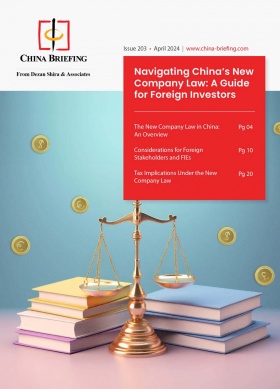China’s 2024-25 Energy Conservation and CO2 Reduction Plan – Compliance Considerations for Businesses
China is turning its attention once again to climate targets after years of focus on economic growth and recovery. As the country reaches the halfway point to its first major climate target in 2030, a new action plan outlines key environmental targets and tasks for high-emitting industries, such as steel, petrochemicals, cement, and oil refining. These include specific carbon emissions reduction and carbon saving targets for 2024 and 2025. We look at the impact that the new China emissions reduction and energy conservation targets may have on businesses operating in these industries.
On May 23, 2024, the State Council unveiled a fresh action plan for energy conservation and carbon emissions reduction spanning 2024 to 2025.
This initiative aims to reinforce energy conservation and carbon emissions reduction objectives, particularly as China approaches the final stretch of the 14th Five-Year Plan period (2021 to 2025). As the conclusion of this period also signifies the midpoint toward China’s first climate goal of achieving peak carbon emissions by 2030, there is a heightened sense of urgency.
The 2024-25 Action Plan notably singles out industries with high energy consumption and carbon emissions, such as steel production, petrochemicals, non-ferrous metals, and building materials. It establishes clear targets for enhancing energy efficiency and reducing carbon emissions within these sectors, facilitating more effective monitoring and accountability.
For companies operating within these industries, these new targets imply increased scrutiny and a raised compliance bar over the next year and a half.
In this article, we outline the new energy conservation and carbon emissions targets and offer guidance on steps companies can take to ensure compliance.
Key energy conservation and CO2 reduction targets
The headline target in the 2024-25 Action Plan is the reduction of energy consumption and CO2 per unit of GDP for the year 2024. 2025, meanwhile, will be the last year of China’s 14th Five-Year Plan (FYP). The 2025 targets for these indicators were therefore set in 2021 when the 14th FYP was released.
| Energy Consumption and Emissions Reduction Targets Per Unit of GDP | |||
| Indicator | 2024 target | 14th FYP target (2025) | 2021-2023 result |
| Reduction in energy consumption per unit of GDP | About 2.5% yoy | 13.5% from 2020 levels | 0.5% yoy (2023)
0.1% yoy (2022) 2.7% yoy (2021) |
| Reduction in CO2 emissions per unit of GDP | About 3.9% yoy | 18% from 2020 levels | 0% yoy (2023)
0.8% yoy (2022) 3.8% yoy (2021) |
Due to the impact of the COVID-19 pandemic, the Chinese government’s focus since the release of the 14th FYP has been on economic growth and recovery, rather than the environment. As a result, the country has fallen behind its energy consumption and CO2 emissions reduction targets. Although the 2024-25 Action Plan sets targets for 2024, it stops short of committing to the 2025 targets in the 14th FYP, instead stating that China will “make every effort” to meet these energy-saving and carbon-reduction targets.
Besides the targets related to the 14th FYP goals, the 2024-25 Action Plan also sets out further targets for the reduction of energy consumption within industries, increasing non-fossil fuel energy consumption, and notably, specific targets for energy conservation and the reduction of CO2 emissions. These targets and past progress are summarized in the table below.
| Key Energy Consumption and Reduction Targets in 2024-25 Action Plan | |||
| Indicator | 2024 target | 2025 target | Previous achievement |
| Reduction in energy consumption per unit of added value of industrial enterprises above the designated size* | 3.5% | NA | 2021-2022: 6.8% |
| Proportion of non-fossil energy consumption | 18.9% | 20% | 2023: 17.7% |
| Energy saving in standard coal equivalent in key areas and industries | 50 million tons | 50 million tons | / |
| Reduction in CO2 emissions in key areas and industries | 130 million tons | 130 million tons | / |
| * Those with a main annual business income of over RMB 20 million. | |||
In addition to the general targets, the action plan further breaks core tasks down to reducing and replacing fossil fuel energy consumption, as well as increasing non-fossil fuel energy consumption.
To reduce and replace fossil fuels, the 2024-25 Action Plan calls for “strictly and reasonably controlling coal consumption” and “optimizing the oil and gas consumption structure”. While the plan lays out strategies for achieving this, it does not provide any specific targets other than, by the end of 2025, “basically eliminating” scattered coal (a type of low-quality coal that is a large contributor to air pollution) in plain areas, as well as small coal-fired boilers and coal-fired facilities (specifically those producing 35 tons of steam per hour or below).
Another part of the strategy to reduce coal consumption is to promote the “orderly” consumption of natural gas, which is less detrimental to air quality than coal, especially for households in northern regions where there is still a reliance on coal for heating. It also promotes the use of advanced bio-liquid fuels and sustainable aviation fuels.
More significant targets have been set for increasing the consumption of non-fossil fuels. The headline target is for the proportion of non-fossil fuel power generation to reach about 39 percent by the end of 2025, which will come from the development of onshore wind and solar power, offshore wind power, hydropower, nuclear power, and biomass energy, among others. By the end of 2022, China’s proportion of non-fossil energy power generation reached 36.2 percent.
In addition, the 2024-25 Action Plan seeks to improve China’s ability to absorb and utilize renewable energy. This will involve accelerating the construction of transmission channels for large-scale wind power and photovoltaic bases, enhancing the power transmission capacity across provinces and regions, improving the carrying capacity of distributed energy, and developing new technologies and models such as microgrids, virtual power plants, and vehicle-to-grid systems.
By the end of 2025, the 2024-25 Action Plan aims for:
- The installed capacity of pumped storage and new energy storage to exceed 62 million kilowatts and 40 million kilowatts respectively (by end-2023, installed capacity of pumped storage and new energy storage reached 51.3 million kW and 22.6 million kW respectively;
- The demand response capacity (the ability of utility providers to influence consumers to adjust consumption to better match power demand and supply) of each region to generally reach 3 to 5 percent of the maximum electricity load; and
- The demand response capacity of regions where the annual maximum electricity load peak-to-valley difference exceeds 40 percent to reach more than 5 percent of the maximum electricity load.
Key industrial targets
In addition to the general, the 2024-25 Action Plan outlines specific targets for eight high-emitting industries. Notably, these include specific targets for reducing the consumption of standard coal equivalent and reducing CO2 emissions in four industries between 2024 and 2025: steel, petrochemicals and chemicals, non-ferrous metals, and building materials.
For instance, for the petrochemicals and chemicals industry, the 2024-25 Action Plan mandates saving 40 million tons of standard coal equivalent in energy and reducing CO2 emissions by 110 million tons.
This is the first time China has provided specific energy-saving and emissions-reduction goals for industries.
|
Key Industry Targets in the 2024-25 Action Plan |
||
| Industry | 2024-25 targets | |
| Steel Industry | From 2024-25:
|
|
|
||
By 2025:
|
||
| Petrochemical and Chemical Industry
|
From 2024-2025:
|
|
|
|
||
By 2025:
|
||
|
||
| Non-Ferrous Metal Industry
|
From 2024-25:
|
|
By 2025:
|
||
|
||
| Building Materials Industry
|
From 2024-2025:
|
|
By 2025:
|
||
| Buildings | By 2025:
|
|
| Transportation | By 2025:
|
|
| Public Institutions | By 2025:
|
|
| Energy-Consuming Products and Equipment
|
By 2025:
|
|
|
||
| * Specified in the Energy Efficiency Benchmarks and Baseline Levels in Key Areas of High-Energy-Consumption Industries (2021 Edition) | ||
In addition to the 2024-25 Action Plan, the National Development and Reform Commission (NDRC) released four energy-saving and carbon reduction action plans for key high-emitting industries, outlining further environmental targets and implementation tasks. These cover the cement, synthetic ammonia, oil refining, and steel industry. The main energy conservation and CO2 reduction targets for the steel industry are the same as in the 2024-25 Action Plan, but more energy-efficient production targets have been added.
| Energy Consumption and Reduction Targets in High-Emitting Industries | |
| Industry | 2025 targets |
| Cement industry | From 2024 to 2025:
|
|
|
| Synthetic ammonia industry | From 2024 to 2025:
|
|
|
| Oil refining | From 2024 to 2025
|
|
|
| Steel | From 2024 to 2025
|
|
|
| * Specified in the Energy Efficiency Benchmarks and Baseline Levels in Key Areas of High-Energy-Consumption Industries (2021 Edition) | |
Compliance considerations for businesses in China
While it is uncertain whether China will meet the targets laid out in the 14th FYP, the 2024-25 Action Plan does indicate that the country will be stepping up efforts to achieve its carbon commitments after years of competing priorities. This could likely mean that companies will come under closer scrutiny over the next year and a half, and be required to adhere to stricter compliance standards.
The 2024-25 Action Plan outlines a number of tasks to ensure the country meets its targets over the next two years. While many of these are not specifically directed at market entities, companies will nonetheless be expected to undertake responsibility and actively participate in achieving these goals.
1. Strengthening assessment and evaluation of responsibilities to energy conservation and carbon reduction targets
The 2024-25 Action Plan specifically calls for “holding enterprises accountable for energy conservation and carbon reduction as their main responsibility”, a clear directive that companies are expected to play their part in meeting the environmental targets.
China already has various green compliance rules in place requiring companies to assess and evaluate their environmental impact. For instance, Clean Production Audit Measures require companies that exceed pollution or energy consumption limits to undergo mandatory clean production audits. Meanwhile, the Measures for the Administration of Legal Disclosure of Enterprise Environmental Information require some companies to compile yearly “Legal Disclosure Report of Environmental Information”.
Companies should consider integrating sustainable practices into their core operations and establish robust monitoring systems to track their environmental impact. For companies operating within the industries targeted in the 2024-25 Action Plan, special care should be taken to ensure they are adhering to energy efficiency benchmarks and other reduction requirements.
2. Strictly reviewing energy conservation and environmental impact assessments for fixed asset investment projects
The 2024-25 Action Plan vows to strengthen energy conservation reviews for new investment projects to prevent the “blind initiation of high energy-consuming, high-emission, and low-level projects”.
It also calls for:
- Including carbon emission evaluation requirements in the energy conservation review of fixed asset investment projects;
- Conducting comprehensive evaluations of project energy use and carbon emissions;
- Strictly implementing the environmental impact assessment system for construction projects; and
- Conducting greenhouse gas emission impact assessments for construction projects in key industries.
This will mean that companies will be required to undergo more rigorous energy reviews and environmental impact assessments when embarking upon new projects, which could add to approval time and administrative costs. It is therefore imperative for companies to factor in energy conservation and carbon reduction targets when planning new investments and ensuring that new projects are designed to adhere to China’s energy efficiency benchmarks.
3. Strengthening energy conservation and carbon reduction management for key energy-consuming entities
The 2024-25 Action Plan mandates the establishment of energy management archives and enhancing the review and submission of energy utilization reports. This includes improving online energy consumption monitoring systems, conducting energy efficiency diagnostics in critical areas, and creating a comprehensive inventory of projects aimed at energy-saving and carbon reduction renovations and equipment upgrades. Additionally, these units must allocate responsibilities for renewable energy power consumption and manage fossil energy consumption budgets, with any excess consumption being offset through the purchase of green electricity certificates.
To comply with these requirements, companies should start by setting up detailed energy management records and ensure regular submission of accurate energy utilization reports. Investing in advanced online energy monitoring systems will help track and manage energy consumption more effectively. Conducting thorough energy efficiency audits will identify areas for improvement, and maintaining a well-organized list of potential energy-saving and carbon reduction projects will streamline implementation.
4. Increasing energy conservation supervision efforts
The 2024-25 Action Plan proposes developing a three-tiered energy conservation supervision system at the provincial, city, and county levels. This system will integrate various enforcement methods, including comprehensive administrative law enforcement, market regulation law enforcement, special equipment supervision, and credit management. It also calls for strengthening the supervision and inspections to ensure energy conservation laws, regulations, policies, and standards are properly implemented.
By the end of 2024, each region is expected to complete energy conservation inspections for over 60 percent of key energy-using units, with full coverage achieved by the end of 2025.
For companies, this means there will be heightened scrutiny and more frequent inspections of their energy use and conservation practices. To comply, companies should ensure they fully understand and adhere to all relevant energy conservation laws, regulations, policies, and standards. Regular internal audits of energy use and conservation measures will help prepare for official inspections. Companies should also maintain thorough records and documentation of their energy management practices and improvements. Investing in compliance training for staff and staying informed about changes in regulations will also be crucial.
5. Enhancing energy consumption and carbon emissions statistical accounting
To enhance energy consumption and carbon emission statistical accounting, there will be a focus on establishing a rapid reporting system for energy usage and carbon emissions statistics in line with energy-saving and carbon reduction objectives. This will involve improving the accuracy and timeliness of data reporting. Additionally, efforts will be made to strengthen the statistical foundation for various energy sources, including fossil and non-fossil energy, as well as energy used as raw materials.
For companies, this emphasizes the importance of having robust systems in place for tracking and reporting energy usage and carbon emissions. Implementing efficient reporting mechanisms and utilizing reliable data sources will be essential. Companies should invest in technologies and tools that facilitate accurate data collection and analysis.
About Us
China Briefing is one of five regional Asia Briefing publications, supported by Dezan Shira & Associates. For a complimentary subscription to China Briefing’s content products, please click here.
Dezan Shira & Associates assists foreign investors into China and has done so since 1992 through offices in Beijing, Tianjin, Dalian, Qingdao, Shanghai, Hangzhou, Ningbo, Suzhou, Guangzhou, Haikou, Zhongshan, Shenzhen, and Hong Kong. We also have offices in Vietnam, Indonesia, Singapore, United States, Germany, Italy, India, and Dubai (UAE) and partner firms assisting foreign investors in The Philippines, Malaysia, Thailand, Bangladesh, and Australia. For assistance in China, please contact the firm at china@dezshira.com or visit our website at www.dezshira.com.
- Previous Article China’s Wine Market Outlook: Trends and Opportunities
- Next Article China May 2024 Economic Roundup: Consumption and Trade Rebound Amid Slowing Industrial Output




























